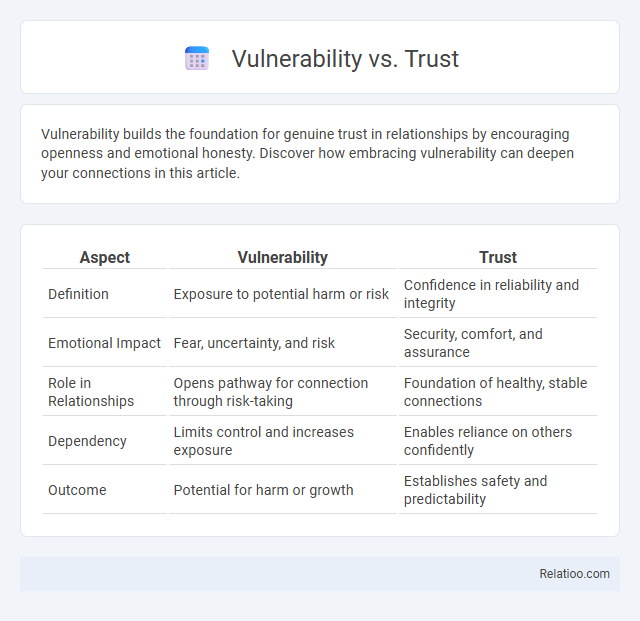Vulnerability builds the foundation for genuine trust in relationships by encouraging openness and emotional honesty. Discover how embracing vulnerability can deepen your connections in this article.
Table of Comparison
| Aspect | Vulnerability | Trust |
|---|---|---|
| Definition | Exposure to potential harm or risk | Confidence in reliability and integrity |
| Emotional Impact | Fear, uncertainty, and risk | Security, comfort, and assurance |
| Role in Relationships | Opens pathway for connection through risk-taking | Foundation of healthy, stable connections |
| Dependency | Limits control and increases exposure | Enables reliance on others confidently |
| Outcome | Potential for harm or growth | Establishes safety and predictability |
Understanding Vulnerability: A Key Human Experience
Understanding vulnerability is essential for deep emotional connections and personal growth because it involves openly sharing fears, insecurities, and authentic feelings. You can build trust by embracing vulnerability, which breaks down emotional barriers and fosters genuine relationships. Recognizing vulnerability as a strength rather than a weakness promotes empathy, resilience, and improved communication in all interpersonal dynamics.
Defining Trust in Relationships and Society
Trust in relationships and society is the confident expectation that others will act with integrity, reliability, and benevolence, forming the foundation for cooperation and emotional connection. Vulnerability arises when individuals expose their weaknesses or uncertainties, creating opportunities for deeper trust but also emotional barriers if trust is breached. Emotional barriers develop when fear, past betrayals, or insecurity hinder openness, obstructing the establishment of genuine trust and mutual understanding.
The Interconnection Between Vulnerability and Trust
Vulnerability acts as a catalyst in building trust by encouraging open and honest communication, which reduces emotional barriers that often hinder authentic connections. When you expose your true self without fear of judgment, trust deepens, fostering an environment where emotional barriers begin to dissolve, allowing for more meaningful and supportive relationships. The interconnection between vulnerability and trust highlights that embracing emotional openness is essential for nurturing strong interpersonal bonds.
Psychological Foundations of Vulnerability
The psychological foundations of vulnerability reveal that embracing openness requires overcoming emotional barriers rooted in fear of judgment or rejection. Trust acts as a crucial mediator, enabling You to lower defenses and foster genuine connections by signaling safety and acceptance. Understanding these dynamics helps in navigating the delicate balance between vulnerability and emotional protection for authentic relationships.
Building Trust Through Openness
Building trust through openness requires embracing vulnerability as a strength rather than a weakness, fostering authentic connections that break down emotional barriers. Transparency in communication creates a foundation for mutual understanding, encouraging others to share openly and deepen relational bonds. Consistent honesty and empathetic listening reveal genuine intentions, making trust a natural outcome of shared emotional experiences.
Risks and Rewards of Being Vulnerable
Being vulnerable involves exposing emotions and personal truths, which can lead to deeper trust and stronger emotional connections but also carries the risk of rejection or emotional pain. Emotional barriers often protect individuals from hurt, yet they may hinder authentic relationships and personal growth. Balancing vulnerability requires assessing the potential rewards of intimacy against the risks of exposure and maintaining trust as a foundation for meaningful interactions.
Barriers to Trust: Fear and Past Experiences
Fear and past experiences significantly contribute to barriers to trust, as individuals often associate vulnerability with potential emotional harm or betrayal. Negative encounters shape cognitive biases that heighten anxiety, making it difficult to open up and form genuine connections. Overcoming these barriers requires conscious efforts to recognize and address the impact of fear and traumatic memories on interpersonal relationships.
Cultivating Trust in Personal and Professional Life
Cultivating trust requires embracing vulnerability, as openness and authentic communication break down emotional barriers that hinder genuine connections. Your ability to consistently demonstrate honesty, empathy, and reliability fosters deeper relationships both personally and professionally. Trust built on mutual respect strengthens collaboration, enhances emotional safety, and promotes long-term commitment.
Practical Strategies to Embrace Vulnerability
Embracing vulnerability involves practical strategies such as practicing self-compassion, sharing personal experiences with trusted individuals, and gradually exposing oneself to emotional risks in safe environments. Building trust requires consistent communication, active listening, and demonstrating reliability to break down emotional barriers. These techniques enhance emotional resilience and foster deeper connections by transforming vulnerability into a strength rather than a weakness.
The Long-Term Impact of Vulnerability and Trust
Vulnerability fosters genuine connections by allowing you to express authentic emotions, which builds trust over time and strengthens relationships. Trust serves as the foundation for emotional safety, reducing barriers and encouraging open communication that supports long-term relational growth. Overcoming emotional barriers through vulnerability enhances mutual understanding and resilience, creating lasting bonds that withstand challenges.

Infographic: Vulnerability vs Trust
 relatioo.com
relatioo.com